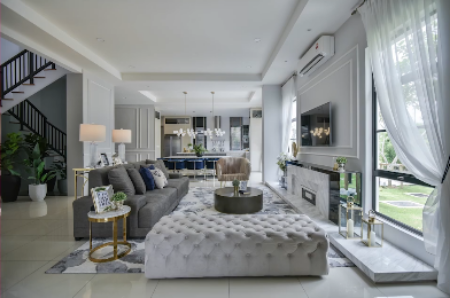Blog categories
Blog archive
RSS Blog posts tagged with 'decor tips'
Blog Filters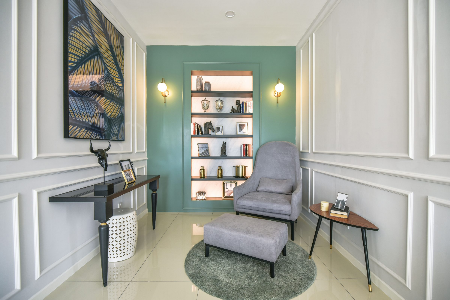
6 Ways to Cosy Up Your Chill-Out Spot
Friday, November 20, 2020
If you have extra room in your living area, it's good to have a quiet chill-out spot. Perfect for reading your favourite novel, taking a nap or simply having a quiet moment, this spot should be beautifully decorated with cosy materials to create a comfortable ambience. Here are five ways you can blend cosy style with fashionable furnishing in your cosy corner. 1 Calm Composure Keep calm and paint the area with soothing colours. Choose neutral tones for your furnishing but spice it up with brighter details to uplift the space. SQFT Space Design Management
SQFT Space Design Management
2 Haute Seat Your choice of seating furniture is key here. Choose one that truly fits the way you would use your chill-out spot.
 Interior design: Yong Studio
Interior design: Yong Studio
3 Lounge Luxe If your chill-out spot is in the study, always include a lounge or sofa bed for those days when you need a power nap.
 Interior design: The Roof Studio
Interior design: The Roof Studio
4 All Together Just because it is meant for quiet moments, you don't have to use your chill-out space alone. Dedicate a corner in the dining room for peaceful quality time with your loved ones.
 Interior design: Surface R
Interior design: Surface R
5 Memento Magic Decorate the space with items that hold sentimental value for you. For instance a favourite armchair or family photos on the wall.
 Interior design: Living Space Creative Design
Interior design: Living Space Creative Design
6 Inside Out Don't limit yourself to spaces inside the house. Take your cosy spots outside too. The fresh air and green views will definitely put you in a better mood.
 Interior design: GI Design
Interior design: GI Design
Post by Lily Wong
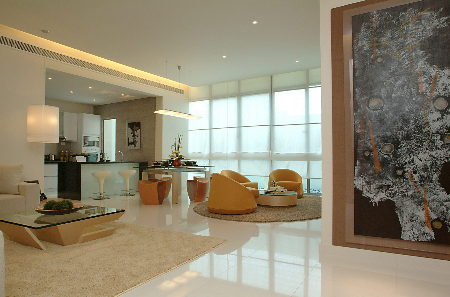
Airy Aesthetics: 5 Open Plan Living Room Ideas
Friday, November 20, 2020
Perhaps you started out with an open layout in new your home, or maybe you are about to take a pnuematic hammer to your non-load bearing walls. Either way, you may find yourself bewildered by the vast range of things that can be done with the enlarged space. To help you narrow down the options and decide on a design approach that suits your needs, we assembled our panel of designers and came up with this list of the top five decorating ideas for large spaces.
1. BorderlessIf you have a surplus of square-footage in your living room, and are not keen on acquiring more furnishings to fill in the space, we recommend flaunting it. Try arranging living and dining furniture in their respective corners, with plenty of walking room and a sprinkling of subtle decorative features in between to demarcate the spaces. Since urban living became the norm for most of us, nothing speaks of luxury as much as wide walkways bordering expansive spaces - being generous with empty space is probably going to be your first approach if extravagance is the vibe you are aiming for. There is a caveat to be wary of however: leaving too much empty space makes for unpleasant acoustics and an uncomfortable living space - solve that by including additional soft furnishings such as carpets or drapery, and building up wall façades to absorb sound.
 Designer: Beverly Home
2. Division by Furnishing
Designer: Beverly Home
2. Division by Furnishing
In the event that the space for wide walkways is lacking, consider arranging your living room furniture so that the largest piece (typically the sofa) serves as a divider. This enables the room to be visually subdivided, and for the additional space to serve a different function in close proximity. This arrangement can be accomplished with a conventional sofa, or an L-shaped living room set with slightly more space, resulting in an effective division without other visual cues. The colour of the dividing furniture will affect the visual weight of the separation when compared to the palette of the room - so go dark for prominence in a predominately white space, or light for subtlety to preserve the sense of air volume.
 Designer: Pocket Square
3. Decorative Walls
Designer: Pocket Square
3. Decorative Walls
A more commonly seen method of dividing spaces can be spotted on walls. Easily implemented wherever space is at a premium, different textures and shades can be presented on thin façades or wall projections to serve as visual cues between spaces. Even though walls are typically missing from an open layout, we recommend building up false wall projections or retaining a portion of existing projections to form small corners in areas with less foot traffic - if there is adequate space. While these projections will deduct from the open layout experience depending on their size, they can often be made to serve both visual and practical functions - such as providing additional shelving space and better acoustics while acting as demarcation.
 Designer: Design Base
4. Faux Archway
Designer: Design Base
4. Faux Archway
Tie together disparate shades and textures on walls with the formation of a non-structural and purely aesthetic archway. In addition to serving as a visual cue, even an archway of minimalist design creates another plane that can be adorned with decorative features such as reflective panels to visually enlarge the space.
 Designer: Metrics Global
5. Demarcating Ceilings and Floors
Designer: Metrics Global
5. Demarcating Ceilings and Floors
In lieu of any other dividing elements, details on the ceiling and the approximate size of those features being mirrored on the floor in the form of tiles or an area carpet, will result in your separate spaces being distinctly defined. Because of their visual prominence and requisite size, these features work best in an adequately large space decorated with a unified colour palette. If you have the space to spare, aim for lighting in oversized geometric shapes on the ceiling and a large deep-pile carpet on the floor to envelop your seating lounge in cosy light and textures.
 Designer: Q1 Interior Concept
Is your seating lounge the kind with an extra-high ceiling? Read about how to select lighting for these cavernous spaces here.
Designer: Q1 Interior Concept
Is your seating lounge the kind with an extra-high ceiling? Read about how to select lighting for these cavernous spaces here.
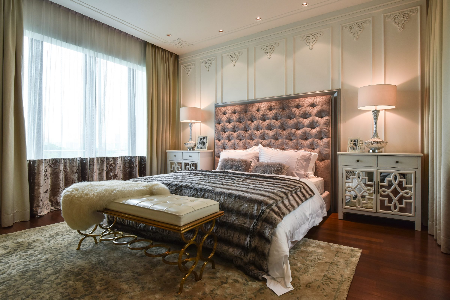
5 Bedroom Styling Ideas to Inspire You
Friday, November 20, 2020
Looking for styling ideas on how to decorate your bedroom? There are many ways to do so: you can piece together different furnishings and decorations to assemble something approaching comfort, or you could design your bedroom with an achievable end result in mind. Here are more ideas to get you inspired.
 Interior design by: SQFT Space Design Management
Interior design by: SQFT Space Design Management
1. Romantic Impressions Time-tested classical detailing in combination with peach-toned architectural finishes and decorations lend this bedroom a delicately feminine personality. The lightweight décor is complemented by rich fabrics of various shades running from the tops of walls to the floors - with cream drapery, a headboard of button-backed upholstery, and other fuzzy accompaniments rounding off the edges of the bed platform.
 Interior design by: Stylecraft Design
Interior design by: Stylecraft Design
2. Geometric Variation A simplistic interior composed of geometric designs is kept from becoming overly uniform with a variation of shapes. The wallpaper bears a vaguely Asiatic repeating motif and the decorative feature wall frames a tight cluster of mirrored hexagonal tiles subtly backlit against the horizontal wood grains. The décor is layered with various wood tones and grains to add depth and complexity to the compact space.
 Interior design by: SQFT Space Design Management
Interior design by: SQFT Space Design Management
3. Diverse Influence The dark expanse portrays a space of the masculine persuasion, while the slender metallic frames born of minimalist philosophy and bevelled mirrored panels illustrate an eclectic personality with affluent sensibilities. To bolster the opulent ambiance, the square metal pipe frames are powder coated in a shade reminescent of gold, and the varied assembly is accented with Anglophilic decorations evoking imagery of Redcoats and the English countryside complementing the plaid fabrics.
 Interior design by: SQFT Space Design Management
Interior design by: SQFT Space Design Management
4. Dainty Sanctuary When a bedroom is planned with a walk-in wardrobe space and a transparent division between bed and bath, the result is an indulgant private space that would be cause any reasonable person to pine for home. The peach and off-white palette renders a feminine vibe, complemented with classical detailing and an abundance of reflective surfaces to create an intimate and luxuriously appointed sanctuary deserving of envy.
 Interior design by: Stylecraft Design
Interior design by: Stylecraft Design
5. Refined Simplicity In this bedroom, shades and shapes are reduced to their simplest forms for an elegantly minimalist décor - the pallete is limited to a two-toned combination of eggshell white and grenish grey, in the decorative feature wall lined with fine right angles and in the glossy, reflective panels framing the sides. The selection of white bedsheets, a blanket patterned with geometry, and the inclusion of a few cut fern fronds brings the pallette to a head.
Click here for more bedrooms.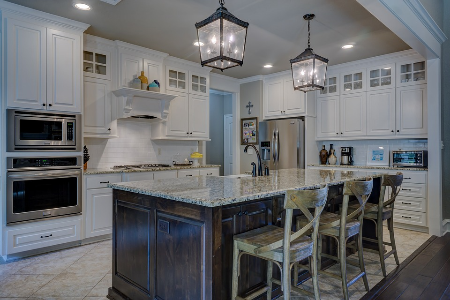
Light and Bright: 5 Kitchen Lighting Tips to Enhance Your Space
Friday, November 20, 2020
When a homeowner is busy remodeling the kitchen, often the lighting isn't considered to be a priority. However, having beautiful and efficient lighting in the kitchen not only adds to the functionality and adequate illumination, but also enhances the outstanding looks that can often be accomplished by rather simple and affordable remedies. 1. Plan Your Lighting
No one overhead ceiling-mounted fixture or recessed lighting can light the entire kitchen properly, so investigate the different types of light and the number and placement of fixtures needed for your space for the maximum benefit. For example, task lighting is most effective when it is placed below the upper cabinets with fluorescent under-cabinet lighting. Or you can install a chandelier hanging from the ceiling so that it makes it easy to read a recipe and do prep work on the work surface of an island or table.
1. Plan Your Lighting
No one overhead ceiling-mounted fixture or recessed lighting can light the entire kitchen properly, so investigate the different types of light and the number and placement of fixtures needed for your space for the maximum benefit. For example, task lighting is most effective when it is placed below the upper cabinets with fluorescent under-cabinet lighting. Or you can install a chandelier hanging from the ceiling so that it makes it easy to read a recipe and do prep work on the work surface of an island or table.
 2. Highlight Your Kitchen
Accent lighting gives depth and dimension such as adjustable fixtures inside glass-front cabinets that will illuminate precious collections, hobbies, art, china, glassware, knickknacks, and other items that will make your kitchen unique, colorful, and be a conversation piece.
2. Highlight Your Kitchen
Accent lighting gives depth and dimension such as adjustable fixtures inside glass-front cabinets that will illuminate precious collections, hobbies, art, china, glassware, knickknacks, and other items that will make your kitchen unique, colorful, and be a conversation piece.
 3. Go White
White reflects light and bounces it back into the room, making the space feel brighter and well-illuminated while allowing a lower wattage of bulbs and a conservation of energy. So consider white for the walls, ceiling, cabinets, and countertops to maximize the light. A kitchen having dark surfaces requires one-third more light than a kitchen with lighter surfaces.
3. Go White
White reflects light and bounces it back into the room, making the space feel brighter and well-illuminated while allowing a lower wattage of bulbs and a conservation of energy. So consider white for the walls, ceiling, cabinets, and countertops to maximize the light. A kitchen having dark surfaces requires one-third more light than a kitchen with lighter surfaces.
 4. Use Pendant Lamps
Pendant lights not only give a lot of direct task lighting, but they also allow for a variety of sizes, shapes, colors, styles, and decorative features to add to the looks of your kitchen.
4. Use Pendant Lamps
Pendant lights not only give a lot of direct task lighting, but they also allow for a variety of sizes, shapes, colors, styles, and decorative features to add to the looks of your kitchen.
 5. Install Dimmers
Have dimmers on the various lights so that you can have bright light when you are cooking and doing chores, but then be able to dim the lights to linger over a meal or dessert or create warmth and ambience.
Article courtesy of Patriot LED
5. Install Dimmers
Have dimmers on the various lights so that you can have bright light when you are cooking and doing chores, but then be able to dim the lights to linger over a meal or dessert or create warmth and ambience.
Article courtesy of Patriot LED

Alfresco Furnishing: How to Choose Outdoor Furniture
Friday, November 20, 2020
If you're in the midst of designing your outdoor spaces - or if you've just come across our ideas on what to do with your urban garden space, and now find yourself wondering how to go about furnishing your outdoor sanctuary, then this is the guide for you. To help you find the right furniture, we studied a selection of outdoor spaces around the country and arrived at the following list of pointers to keep in mind when looking for your garden furniture.
Function As with any other space, consider the intended purpose of a space before setting out on your search for furniture. Whether your aim is to create a solitary seating lounge or an additional area for communal dining, the function of your outdoor space will help you to determine the kind of furnishings required. Also look to whether your outdoor space is dedicated or shared: a dedicated seating lounge will be able to host furnishings of greater weight and size, while a shared space containing both dining and seating areas may require discrete furnishings that can be moved or stacked in storage as needed.
Size Is your outdoor space wide or compact? A narrow outdoor space would not typically benefit from the placement of furnishings with hefty frames, often making for cramped quarters that contradict the expanse of the outdoors. A more balanced composition could be achieved in narrow outdoor spaces using furniture of sleek designs, with robust furnishings being more suited to wide and uninterrupted spaces.
 Image Credit: Les Asia
Image Credit: Les Asia
As we mentioned previously in our guide on selecting dining tables, there are rules-of-thumb that decorators use to achieve comfortable arrangements of furniture within a defined space. These guidelines suggest that the space typically required between dining furniture and walls would be around 900cm and 1.3 meters, while each seat should be afforded around 60cm to 70cm of space on both sides for adequate elbow room. This same guideline would be applicable for outdoor spaces surrounded by lush greenery, with greater distances afforded if the outdoor space comes with uninterrupted views.
 Interior design by: Zids Design
Interior design by: Zids Design
Material The consideration of the kind of material that your outdoor furniture should be composed of: wood, stone, metal, or plastic, is largely dependant on the style you want to affect, but it would be vital to keep in mind that the material choice will have an effect on the visual weight and longevity of your furniture.
 Interior design by: Sky Creation
Interior design by: Sky Creation
Outdoor furnishings composed of stone or wood are ideal for arrangements paying homage to traditional styles, but they tend to be bulkier in design, requiring more space as a result so as not to appear overly imposing. As we found with kitchen countertops: stone and wood materials are naturally porous, requiring specialised treatment and dedicated maintenance with sealing waxes or oils to keep their lustre.
 Interior design by: Latitude Design
Interior design by: Latitude Design
A greater variety of styles may be achieved with outdoor furnishings constructed out of metal or plastic due to their relatively higher strength - even in designs with narrow profiles. With the clear exception of wrought iron furniture, the tendency apparent in metal or plastic furnishings is a lean toward modern and minimalist designs, making metal and plastic furniture ideal for smaller outdoor spaces or for complementing contemporary interiors.
Click here to see some delectable outdoor arrangements.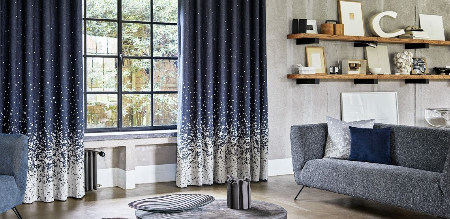
Balancing Tones: Decorating with Blue and Grey
Friday, November 20, 2020
Blues and greys are a wonderful combination to create a modern and sophisticated interior. To show you how to work with these colours, Curtains Place's latest interior collection, Senses offer a good example on how to add on the essence of comfort and design with a stylish sense of simplicity that can be achieved using this palette. Natural colours combined with rich tones of blue and lavender grey are used in this inspired decor using the Senses collection. The blue in this look is complemented with the raw hues on the walls and floors. Colours get their depth in the textures of the materials. The contrast of white in the patterns, walls and accessories add light to the look. The denim look of the two-toned Arezzo range for the upholstery enhances the natural balance of the colour palette.
Natural colours combined with rich tones of blue and lavender grey are used in this inspired decor using the Senses collection. The blue in this look is complemented with the raw hues on the walls and floors. Colours get their depth in the textures of the materials. The contrast of white in the patterns, walls and accessories add light to the look. The denim look of the two-toned Arezzo range for the upholstery enhances the natural balance of the colour palette.
 Styling Tips:
Styling Tips:
- Combine the softness of lavender grey with the intensity of ink blue for a colour combination that creates a restful vibe.
- Natural colour palettes create a feel of relaxed cosiness.
- Leaving a wall exposed or unfinished can add an interesting element to your room can create great backdrop for decoration. You can also opt for a raw textured wall covering. Linen and linen-mixes have inherent properties of insulation and drape excellently.
- Colours translate naturally on linen creating beautiful shades.
- Add chic metallic tones with linen-mixes.
- Nature-inspired patterns make for a simple elegance with their subtle colour palettes.
- Textured and natural upholsteries are the must haves for 2018 in upholstery. Combine it with pillows in rich tones.

Urban Oases: 5 Outdoor Garden Ideas for Urban Homes
Friday, November 20, 2020
The possibilities that come with large gardens are limitless: you could put in a pond for fish, a pool for yourself, a water feature to sit by, wooden decking for large gatherings, a farm so that you never have to go grocery shopping ever again, and a meandering rock path or flowing brook surrounded by lush foliage for a meditative sanctuary. But for most of us living in the city, our options are limited by the space between the substructures of our homes and the edges of our property lines, so we peeked into some yards to list the following ideas for decorating your small garden spaces.
1) PlantersIf you're living in a high-rise structure, your outdoor garden options are probably limited to the balcony. But don't let that dishearten you, as these deceptively narrow spaces can be transformed into lush gardens with the addition of some pots, bowls, boxes, and improvised planters adorning the railings, floor, or walls. If your balcony does not receive much sunlight, consider planting some shade-loving varieties.
 This balcony goes a step further towards an immersive garden space with the use of artificial grass carpeting on the floor. Designer: X-Two Concept
2) Hardscaping
This balcony goes a step further towards an immersive garden space with the use of artificial grass carpeting on the floor. Designer: X-Two Concept
2) Hardscaping
Perhaps gardening is just not your forté and you would prefer to devote your garden to additional space for hosting gatherings instead - implementing wood decking or some other form of hardscape provides a functional platform while reducing some of the landscaping concerns. With a hardscape deck as the centrepiece of an outdoor space, plants become more of an optional adornment that can be replaced by furniture, lighting, or other forms of decoration.
 The wooden deck of this home leaves a fringe of grass around the edges for a striking contrast between the green and the wood tones. Designer: IDS Interior
3) Rock Garden
The wooden deck of this home leaves a fringe of grass around the edges for a striking contrast between the green and the wood tones. Designer: IDS Interior
3) Rock Garden
While hardscaping makes for functional spaces, the act of replacing garden space with architectural finishes does not allow much room for creative expression. For those seeking to unleash their inner artist, we highly recommend the meditative exercise of creating a Zen space in a garden of any size, using your own curated selection of fine or coarse sand, gravel, pebbles, and larger stones. Restrict the shape and size of your rock garden with wood and moss-covered stones - or let it flow freely, then plant herbs or other small plants and maybe even some decorative sculptures among the stones to complete the arrangement.
 Image credit: ScapeXpert
4) Water Feature
Image credit: ScapeXpert
4) Water Feature
A significant component of a home with favourable “Feng Shui” - the water feature is almost always expected of both residential and commercial properties in Asia. It is generally a positive thing to have a water feature facing a window or doorway into the home, more so with some varieties of Asian carp (鲤鱼; pinyin: Li Yu) living in it and Chinese Evergreen (萬年青; pinyin: Wan Nian Qing) or other plants around it.
 What would have been an insignificant side yard is turned into a meditative corner complete with the sounds of falling water. Designer: Homlux Interior Furnishing
5) Furniture
What would have been an insignificant side yard is turned into a meditative corner complete with the sounds of falling water. Designer: Homlux Interior Furnishing
5) Furniture
Any avid gardener will tell you that the best way to enjoy the result of your yard work is with a lawn chair and a cool drink in hand. Placing seating and table surfaces in and around your garden makes for a pleasant change from indoor seating rooms, that and it serves as an excuse to show off your garden. Select ready-made lounge furniture with frames made of natural materials such as wood and stone, or engineered materials such as carbon-coated steel, wrought iron, and UV-cured plastic to better endure the elements, or even construct your own out of reclaimed materials for a bespoke arrangement.
 As this outdoor lounge has the benefit of a roof, the ratan weave furnishings will last significantly longer. Designer: Space Living
Figure you have the space for a pool? Read our guide on pool design considerations here.
As this outdoor lounge has the benefit of a roof, the ratan weave furnishings will last significantly longer. Designer: Space Living
Figure you have the space for a pool? Read our guide on pool design considerations here.
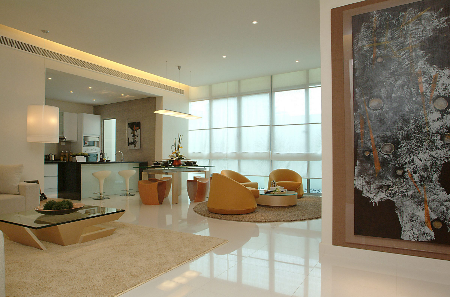
Airy Aesthetics: 5 Open Plan Living Room Ideas
Friday, November 20, 2020
Perhaps you started out with an open layout in new your home, or maybe you are about to take a pnuematic hammer to your non-load bearing walls. Either way, you may find yourself bewildered by the vast range of things that can be done with the enlarged space. To help you narrow down the options and decide on a design approach that suits your needs, we assembled our panel of designers and came up with this list of the top five decorating ideas for large spaces.
1. BorderlessIf you have a surplus of square-footage in your living room, and are not keen on acquiring more furnishings to fill in the space, we recommend flaunting it. Try arranging living and dining furniture in their respective corners, with plenty of walking room and a sprinkling of subtle decorative features in between to demarcate the spaces. Since urban living became the norm for most of us, nothing speaks of luxury as much as wide walkways bordering expansive spaces - being generous with empty space is probably going to be your first approach if extravagance is the vibe you are aiming for. There is a caveat to be wary of however: leaving too much empty space makes for unpleasant acoustics and an uncomfortable living space - solve that by including additional soft furnishings such as carpets or drapery, and building up wall façades to absorb sound.
 Designer: Beverly Home
2. Division by Furnishing
Designer: Beverly Home
2. Division by Furnishing
In the event that the space for wide walkways is lacking, consider arranging your living room furniture so that the largest piece (typically the sofa) serves as a divider. This enables the room to be visually subdivided, and for the additional space to serve a different function in close proximity. This arrangement can be accomplished with a conventional sofa, or an L-shaped living room set with slightly more space, resulting in an effective division without other visual cues. The colour of the dividing furniture will affect the visual weight of the separation when compared to the palette of the room - so go dark for prominence in a predominately white space, or light for subtlety to preserve the sense of air volume.
 Designer: Pocket Square
3. Decorative Walls
Designer: Pocket Square
3. Decorative Walls
A more commonly seen method of dividing spaces can be spotted on walls. Easily implemented wherever space is at a premium, different textures and shades can be presented on thin façades or wall projections to serve as visual cues between spaces. Even though walls are typically missing from an open layout, we recommend building up false wall projections or retaining a portion of existing projections to form small corners in areas with less foot traffic - if there is adequate space. While these projections will deduct from the open layout experience depending on their size, they can often be made to serve both visual and practical functions - such as providing additional shelving space and better acoustics while acting as demarcation.
 Designer: Design Base
4. Faux Archway
Designer: Design Base
4. Faux Archway
Tie together disparate shades and textures on walls with the formation of a non-structural and purely aesthetic archway. In addition to serving as a visual cue, even an archway of minimalist design creates another plane that can be adorned with decorative features such as reflective panels to visually enlarge the space.
 Designer: Metrics Global
5. Demarcating Ceilings and Floors
Designer: Metrics Global
5. Demarcating Ceilings and Floors
In lieu of any other dividing elements, details on the ceiling and the approximate size of those features being mirrored on the floor in the form of tiles or an area carpet, will result in your separate spaces being distinctly defined. Because of their visual prominence and requisite size, these features work best in an adequately large space decorated with a unified colour palette. If you have the space to spare, aim for lighting in oversized geometric shapes on the ceiling and a large deep-pile carpet on the floor to envelop your seating lounge in cosy light and textures.
 Designer: Q1 Interior Concept
Is your seating lounge the kind with an extra-high ceiling? Read about how to select lighting for these cavernous spaces here.
Designer: Q1 Interior Concept
Is your seating lounge the kind with an extra-high ceiling? Read about how to select lighting for these cavernous spaces here.
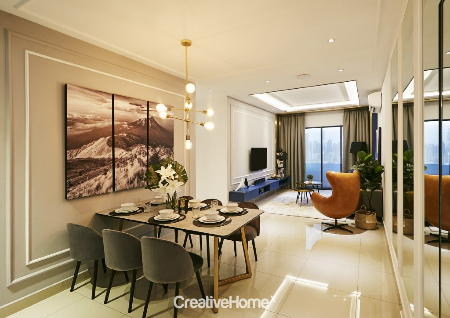
7 Tricks to Make Space Look Larger|Creative Home
Tuesday, October 20, 2020
If you've got a small living room and you wish it were bigger than you thought, worry not, we've got you covered! The 7 tricks will help enlarge a space for at least double its size.